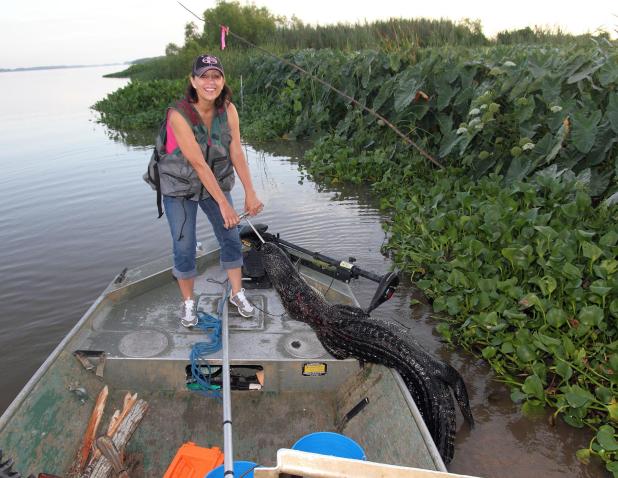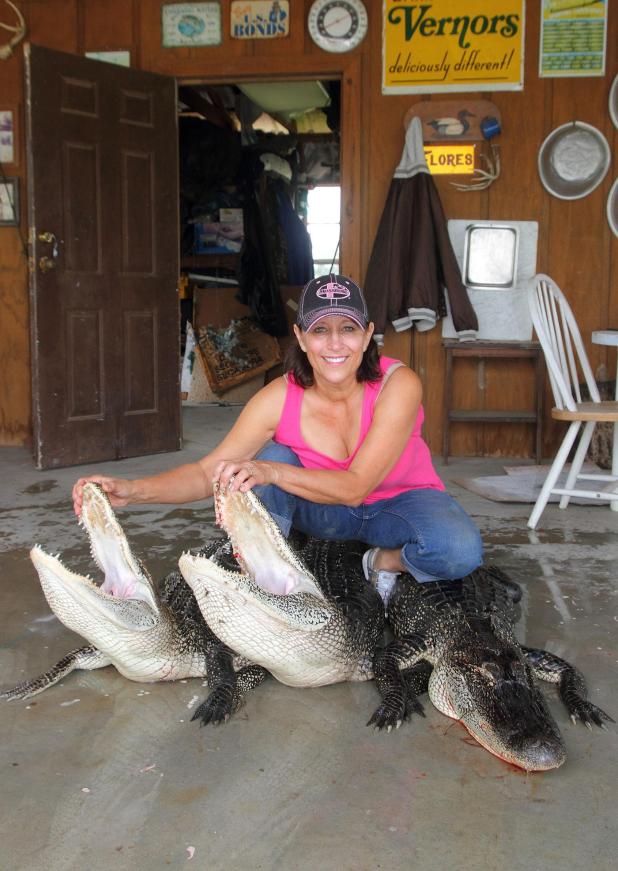
The Review/John K. Flores
Christine Flores pulls in a 7-foot, 9-inch alligator caught during a lottery hunt several years ago on the Atchafalaya Delta Wildlife Management Area.

Christine Flores shows three alligators caught during a lottery hunt on the Atchafalaya Delta WMA.
John K. Flores: Gator adventure begins with state lottery
In the fall of 1984, I made my first alligator hunt with my father-in-law. Growing up in Michigan, believe me, I never dreamed alligator hunting would be the kind of adventure I’d ever participate in, let alone something I’d do commercially. Alligators were something you’d see in a zoo or watch Tarzan wrestle on television.
Historically, more than a half century ago, alligator numbers had plunged precipitously due to habitat loss and over-hunting, where something had to be done. In 1967 they were placed on the endangered species list by the United States Fish and Wildlife Service.
By the time I made my first hunt in ’84, alligator numbers had rebounded and were in the throes of making a full recovery. The recovery has been so remarkable that in the past 50 years, the alligator population increased from less than 100,000 to more than 2 million, according to the Louisiana Department of Wildlife and Fisheries website.
Managed as a commercial renewable resource the LDWF, during the early post recovery years, started allowing a modest, but heavily regulated commercial wild alligator harvest. However, the road to recovery apparently wasn’t an easy one.
On more than one occasion when visiting my father-in-law, the subject of fishing and hunting alligators came up. We’d talk late into the evening, and he’d tell me stories about how they were still hunted illegally even after the USF&WS closed the season in ’67.
“It wasn’t until they stopped the buyers,” he would tell me, when things changed and began to turn around. And, what a turnaround it has been.
Today, alligators have become a real nuisance. They’re commonly hit by automobiles while crossing highways, especially at night. They often make their way up
drainage ditches and into people’s yards requiring removal. What’s more, ask any fisherman to see if an alligator has ever bothered his cork while fishing bream and sac-a-lait.
In fact, my next-door neighbor called me a few months back to help him catch a little two-footer that came from a pond across the street and took up residence in his backyard. We caught and returned the little booger to the pond before it had any chance of eating my neighbor’s chickens.
For over a decade, wild alligator hide prices have been pretty much in the tank. Though there has been some demand for alligator meat, there has been less interest from the fashion industry and other luxury markets.
As a result, in recent years, some land companies have not participated in the annual commercial harvest of gators, which has led to an under harvested overabundance of these reptiles.
Still, from an adventurous outdoor activity, alligator hunting just may be something folks may be interested in.
In a press release dated May 19, 2023, the LDWF announced its annual lottery alligator harvest, where some 600 lucky applicants will have the opportunity to harvest
over 1,900 alligators on 49 wildlife management areas and public lakes across the state.
There is a $5 application fee, along with a $5 transaction fee when applying. If you are one of the lucky winners of the gator lottery, you’ll be required to purchase a $25 alligator hunter license and in addition required to pay $40 for each alligator tag allocated. Alligator applications are due by June 30.
Locally, the Atchafalaya Delta WMA is one of the lottery areas you can apply for. Both my wife and I have drawn out for this WMA in years past. Though the LDWF does a great job demonstrating the proper and safe techniques on how to fish alligators, there are a couple of things you’ll need to know about the Delta they probably won’t mention.
First, the Atchafalaya Delta is tidal. Quite often there’ll be 15 to 20 feet of sandy flat between deep water and vegetated marsh, where there are no tree limbs to tie a line to. In this case you’ll need a pole to suspend your bait and a stob to secure the line.
I learned the hard way that no matter how sharp the point you put on your stob, you still have to drive it down in the sand. So, plan to bring a small sledge hammer.
You’ll be glad you did.
Secondly, pay attention to the rise and fall of the tide. In the morning you might suspend your bait 12 inches above the low tide water line and by night fall it’s under water feeding the crabs. I’ve had to suspend my bait as much as 3 feet out of the water in order for it not go under at high tide.
Alligator heads and hides make wonderful trophies and conversational pieces for your man-cave at home. But, if you’re planning to sell your gators, be sure to line up a buyer and don’t wait until the last minute. Some buyers have quotas and once they reach them it’s over.
Lastly, there’s a lot of 6 and 7 foot alligators out there. If you’re “lucky” enough to get $10 per foot this year, that’s roughly $60 to $70 you’ll get for each of your gators.
Remember, you paid $40 per tag, so don’t plan on making much money, especially when you throw in the cost of fuel, bait, drinks and maybe some snacks.
The alligator lottery hunt isn’t about the money, it’s about the adventure! This year’s lottery season will run from Aug. 30-Nov. 4. For more information about the alligator lottery harvest go to www.wlf.louisiana.gov/assets/Hunting/Alligators/Files/lottery.
John Flores is the Morgan City Review’s outdoor writer. He can be contacted at gowiththeflo@cox.net.
